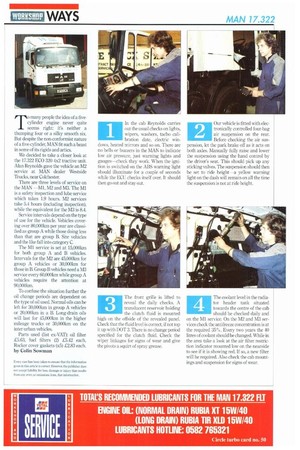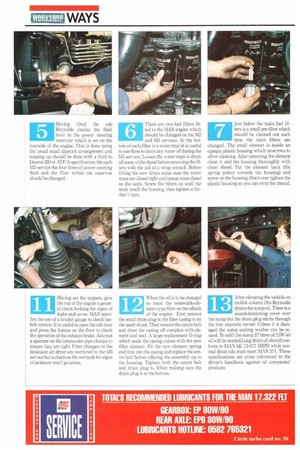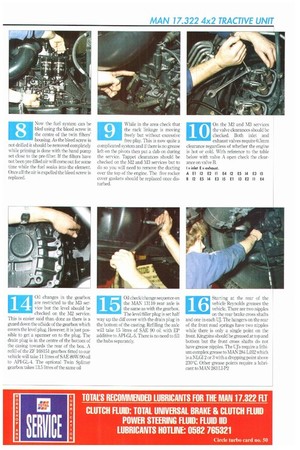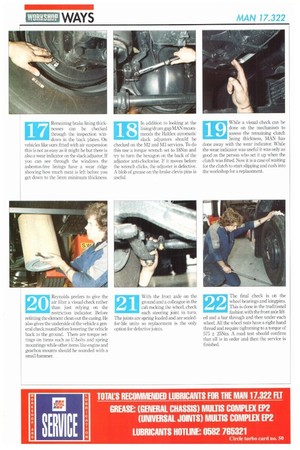T o many people the idea of a five cylinder engine never quite seems right: it's neither a
Page 103

Page 104

Page 105

Page 106

If you've noticed an error in this article please click here to report it so we can fix it.
thumping four or a silky smooth six. But despite the non-conformist nature of a five-cylinder, MAN fit such a beast in some of its rigids and artics.
We decided to take a closer look at the 17.322 ECO 320 4x2 tractive unit.
Alan Reynolds gave the vehicle an M2 service at MAN dealer Westside Trucks, near Colchester.
There are three levels of service on the MAN —M1, M2 and M3. The M1 is a safety inspection and lube service which takes 1.9 hours. M2 services take 5.4 hours (including inspection), while the equivalent for the M3 is 8.4.
Service intervals depend on the type of use for the vehicle. Vehicles cover ing over 80,000km per year are classified as group A while those doing less than that are group B. Site vehicles and the like fall into category C.
The Ml service is set at 15,000km for both group A and B vehicles.
Intervals for the M2 are 45,000km for group A vehicles or 30,000km for those in B. Group B vehicles need a M3 service every 60,000km while group A vehicles require the attention at 90,000km.
To confuse the situation further the oil change periods are dependent on the type of oil used. Normal oils can be left for 30,000km in group A vehicles or 20,000km in a B. Long-drain oils will last for 45,000km in the higher mileage trucks or 30,000km on the inter-urban vehicles.
Parts used (list ex-VAT): oil filter .£5.63, fuel filters (2) £5.42 each, Rocker cover gaskets (x5) £2.83 each. by Colin Sowman In the cab Reynolds carries out the usual checks on lights, wipers, washers, tacho calibration date, electric windows, heated mirrors and so on. There are no bells or buzzers in the MAN to indicate low air pressure, just warning lights and gauges—check they work. When the ignition is switched on the ABS warning light should illuminate for a couple of seconds while the ECU checks itself over. It should then go out and stay out.
1
Our vehicle is fitted with electronically controlled four-bag air suspension on the rear. Before checking the air suspension, let the park brake off as it acts on both axles. Manually fully raise and lower the suspension using the hand control by the driver's seat. This should pick up any sticking valves. The suspension should then be set to ride heighta yellow warning light on the dash will remain on all the time the suspension is not at ride height.
2
The front grille is lifted to reveal the daily checks. A translucent reservoir holding the clutch fluid is mounted high on the offside of the revealed panel. Check that the fluid level is correct, if not top it up with DOT 3. There is no change period specified for the clutch fluid. Check the wiper linkages for signs of wear and give the pivots a squirt of spray grease.
3
The coolant level in the radiator header tank situated towards the centre of the cab should be checked daily and on the M1 service. On the M2 and M3 services check the antifreeze concentration is at the required 35%. Every two years the 40 litres of coolant should be changed. While in the area take a look at the air filter restriction indicator mounted low on the nearside to see if it is showing red. If so, a new filter will be required. Also check the cab mountings and suspension for signs of wear.
4
Having tilted the cab Reynolds checks the fluid level in the power steering reservoir which is set on the nearside of the engine. This is done using the usual small dipstick arrangement and topping up should be done with a fluid to Deicron IID or ATF/A specification. On each M3 service the four litres of power steering fluid and the filter within the reservoir should be changed.
There are two fuel filters fitted to the MAN engine which should be changed on the M2 and M3 services. At the bottom of each filter is a water trap (it is useful to use these to drain any water off during the M1 service). Loosen the water traps to drain off some of the diesel before removing the filters with the aid of a strap wrench. Before fitting the new filters make sure the water traps are closed tight and smear some diesel on the seals. Screw the filters on until the seals touch the housing, then tighten a further 3/ turn.
Just below the main fuel filters is a small pre-filter which should be cleaned out each time the main filters are changed. The small element is inside an opaque plastic housing which unscrews to allow cleaning. After removing the element clean it and the housing thoroughly with clean diesel. Put the element back (the spring points towards the housing) and screw on the housing. Don't over tighten the plastic housing as you can strip the thread. Now the fuel system can be bled using the bleed screw in the centre of the twin filters' housing. As the bleed screw is not drilled it should be removed completely while priming is done with the hand pump set close to the pre-filter. If the filters have not been pre-filled air will come out for some time while the fuel soaks into the element. Once all the air is expelled the bleed screw is replaced. W bile in the area check that the rack linkage is moving freely but without excessive free play. This is now quite a complicated system and if there is no grease left on the pivots then put a dab on during the service. Tappet clearances should be checked on the M2 and M3 services but to do so you will need to remove the ducting over the top of the engine. The five rocker cover gaskets should be replaced once disturbed.
10 On the M2 and M3 services
the valve clearances should be checked. Both inlet and exhaust valves require 0.5mm clearance regardless of whether the engine is hot or cold. With reference to the table below with valve A open check the clearance on valve B.
11 Having set the tappets, give
the top of the engine a gener al check looking for signs of leaks and so on. MAN specifies the use of a kricket gauge to check fanbelt tension. It is useful to open the cab door and press the button on the floor to check the operation of the exhaust brake. Also put a spanner on the intercooler pipe clamps to ensure they are tight. Filter changes on the desiccant air dryer are restricted to the M3 service but a check on the wet tank for signs of moisture won't go amiss.
12 When the oil is to be changed
so must the renewable-ele ment-type filter on the offside of the engine. First remove the small drain plug in the filter casing to let the used oil out. Then remove the centre bolt and draw the casing off complete with element and seal. A large replacement 0-ring which seals the casing comes with the new filter element. Fit the new element spring end first into the casing and replace the centre bolt before offering the assembly up to the housing. Tighten both the centre bolt and drain plug to 50Nm making sure the drain plug is at the bottom.
13 After elevating the vehicle on
mobile column lifts Reynolds drains the sump oil. There is a sound-deadening cover over the sump but the drain plug sticks through the rear nearside corner. Unless it is damaged the sump sealing washer can be reused. To refill the sump 27 litres of 15W/40 oil will be needed.Long drain oil should conform to MAN QC 13-017 SHPD while normal drain oils must meet MAN 271. These specifications are cross referenced in the driver's handbook against oil companies' products
14 Oil changes in the gearbox
are restricted to the M3 ser vice but the level should be checked on the M2 service. This is easier said than done as there is a guard down the offside of the gearbox which covers the level plug. However it is just possible to get a spanner on to the plug. The drain plug is in the centre of the bottom of the casing towards the rear of the box. A refill of the ZF 165151 gearbox fitted to our vehicle will take 11 litres of SAE 80W/90 oil to API-GL-4. The optional Twin Splitter gearbox takes 13.5 litres of the same oil
15 Oil check/change sequence on
the MAN 13110 rear axle is the same as with the gearbox.
The level/filler plug is set half way up the diff cover with the drain plug in the bottom of the casting. Refilling the axle will take 15 litres of SAE 90 oil with EP additive to API-GL-5. There is no need to fill the hubs separately.
16 Starting at the rear of the
vehicle Reynolds greases the vehicle. There are two nipples
on the rear brake cross shafts and one in each UJ. The hangers on the rear of the front road springs have two nipples while there is only a single point on the front. Kingpins should be greased at top and bottom but the front cross shafts do not have grease nipples. The CJ's require a lithium complex grease to MAN 284 LiH2 which is a NLGI 2 or 3 with a dropping point above 230°C. Other grease points require a lubricant to MAN 283 L1-P2 17 Remaining brake lining thick
nesses can be checked through the inspection win dows in the back plates. On vehicles like ours fitted with air suspension this is not as easy as it might be but there is also a wear indicator on the slack adjustor. If you can see through the windows the asbestos-free linings have a wear ridge showing how much meat is left before you get down to the 5mm minimum thickness.
18 In addition to looking at the
lining/drum gap MAN recom mends the Haldex automatic slack adjusters should be checked on the M2 and M3 services. To do this use a torque wrench set to 18Nm and try to turn the hexagon on the back of the adjustor anti-clockwise. If it moves before the wrench clicks, the adjuster is defective. A blob of grease on the brake clevis pins is useful.
19 While a visual check can be
done on the mechanism to assess the remaining clutch lining thickness, MAN has done away with the wear indicator. While the wear indicator was useful it was only as good as the person who set it up when the clutch was fitted. Now it is a case of waiting for the clutch to start slipping and rush into the workshop for a replacement.
20 Reynolds prefers to give the
air filter a visual check rather than just relying on the restriction indicator. Before refitting the element clean out the casing. He also gives the underside of the vehicle a general check round before lowering the vehicle back to the ground. There are torque settings on items such as U-bolts and spring mountings while other items like engine and gearbox mounts should be sounded with a small hammer.
21 With the front axle on the ground and a colleague in the
cab rocking the wheel, check each steering joint in turn. The joints are spring loaded and are sealedfor-life units so replacement is the only option for defective joints. The final check is on the wheel bearings and kingpins. This is done in the traditional fashion with the front axle lifted and a bar through and then under each wheel. All the wheel nuts have a right-hand thread and require tightening to a torque of 575 ± 25Nm. A road test should confirm that all is in order and then the service is finished.
22




















































































































